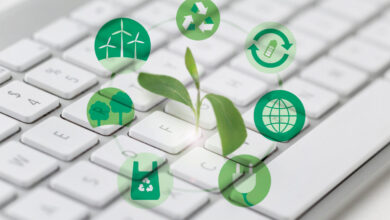How Technology Can Reduce Carbon Footprint

An overall guide on reducing carbon footprint by using technology and conscious personal choices to build a sustainable planet.
As we move forward into the future, the impact of our actions on the environment has become an increasingly important issue. One of the biggest contributors to this impact is our carbon footprint, which refers to the amount of greenhouse gas emissions that are released as a result of our daily activities. Reducing our carbon footprint has become a critical task for individuals, businesses, and governments around the world.
Understanding Carbon Footprints
The carbon footprint refers to the total amount of carbon dioxide (CO2) emissions linked to the activities of an individual or entity, such as a building, corporation, or country. This encompasses direct emissions from the burning of fossil fuels in manufacturing, transportation, and heating. It also includes emissions generated during the production of electricity for the goods and services consumed. Furthermore, the concept of carbon footprint frequently encloses the emissions of other greenhouse gases, such as nitrous oxide, methane, or chlorofluorocarbons (CFCs).
How to Reduce Carbon Footprint
Adopting Carbon and Plastic Neutrality plans
A carbon-neutral organization is dedicated to assessing its CO2 emissions, decreasing them, and counterbalancing them by either reducing emissions elsewhere or eliminating an equal amount of CO2 from the atmosphere. This equilibrium approach is referred to as carbon offsetting. It might include initiatives such as planting trees or investing in sustainable energy.
Plastic neutrality means for every amount of plastic created, an equal amount of plastic waste is retrieved from or prevented from entering the ecosystem. However, the plastic industry is also responsible for at least 232 million tons of planet-warming emissions each year. Many brands are choosing plastic neutrality to mitigate emissions. By adopting these two schemes companies can reduce their carbon footprint.
Reducing Consumption & Emissions
The first step in reducing our carbon footprint is to reduce our energy consumption. This can be achieved by turning off lights and electronics when they are not in use, and using energy-efficient appliances. Reducing water usage can also help to reduce our carbon footprint. This can be achieved by fixing leaks, using water-efficient appliances, and reducing the amount of water used in landscaping. The production and transportation of food contribute significantly to greenhouse gas emissions. By reducing food waste, we can reduce our carbon footprint.
The use of renewable energy sources, such as solar and wind power, can significantly reduce our carbon footprint. Transportation is a major contributor to greenhouse gas emissions. Individuals can reduce their carbon footprint by using public transportation, walking, or cycling instead of driving. Electric cars, Hydrogen cars are excellent alternatives to traditional gasoline-powered vehicles. Using sustainable products can help to reduce our carbon footprint. This includes products made from recycled materials, designed to last longer, and produced using sustainable manufacturing processes.
How Technology Can Help
Technology can play a significant role in helping us to reduce our carbon footprint. Here are some examples of how technology can help.
- Use of blockchain technology
The use of blockchain technology has the potential to enhance transparency, accountability, and traceability of greenhouse gas emissions, making it a valuable tool. This technology enables companies to furnish more precise, dependable, uniform, and easily accessible data on carbon emissions. Smart contracts can be leveraged to effectively calculate, monitor, and document the reduction of carbon footprint throughout the value chain. Furthermore, blockchain can facilitate prompt authentication, and verification of real-time data, and maintain transparent data records.
- Renewables
According to the IEA, renewable energy sources, specifically, wind and solar power, have the potential to offer a substantial supply of low-emission electricity and may account for 35% of the total emissions reductions necessary to achieve a worldwide net-zero energy transition by 2050.
- Carbon capture, usage, and storage (CCUS)
The technology of Carbon Capture, Usage, and Storage (CCUS) facilitates the capture of carbon dioxide (CO2) emissions from highly polluting industrial plants for permanent transportation and storage, thereby contributing to decarbonization. CCUS also supports low-emission methods of generating electricity and hydrogen, which are essential energy carriers in decarbonizing numerous sectors.
- Hydrogen
As a clean and adaptable energy carrier, hydrogen can serve as a replacement for fossil fuels in particular energy applications that are challenging or expensive to electrify. In doing so, hydrogen can play a crucial role in facilitating decarbonization in sectors like heavy industry, chemical manufacturing, and long-distance transportation (such as road freight, shipping, and aviation).
- Use of AI
The utilization of digitalization and artificial intelligence (AI) can enhance the efficient functioning of energy systems and decrease the overall energy demand by minimizing avoidable consumption. AI, in particular, is now acknowledged as the upcoming general-purpose technology with significant implications for data analysis, modeling, and forecasting. It can also increase efficiency and productivity in manufacturing processes and supply chains.
The Bottom Line
The undeniable and severe links between greenhouse gas emissions and climate change cannot be overlooked. The rise in average global temperatures, intensification of extreme weather events, the elevation of ocean levels, and acidification are all ecological hazards caused by human actions. By reducing the carbon footprint, we can play a crucial role in decreasing greenhouse gas emissions. Each person making minor adjustments can collectively have a significant impact on combating climate change. Technology can also play a vital role in helping us to achieve climate goals.
The Disposal Company is helping brands reduce their Carbon footprint by offsetting their plastic & carbon usage. Click here to contact us.




